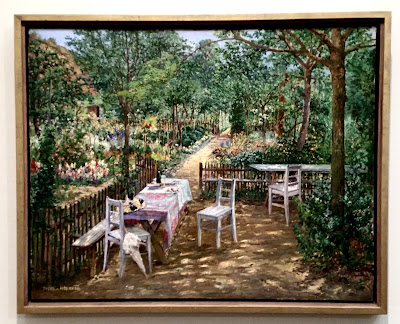My attraction to Vienna is it's reputation as a city of art and architecture - with many fine palaces - one on almost every corner in the old city - and most of which are left-overs from the Astro-Hungarian Empire of the 19th century. These architectural showcases are now primarily used as bait to lure tourists and some as art galleries.
The palaces can wait for future blog posts - but first up is probably the best known building in Vienna - The Secession Building - built in 1897 by Joseph Maria
Olbrich as an architectural manifesto for the Vienna Secession.
The Vienna Secession was formed in 1897 by a group of Austrian artists who had resigned from the Association of Austrian Artists. This movement included painters, sculptors, and architects. The first president of the Secession was Gustav Klimt, and Rudolf von Alt was made honorary president. Other artists of note were Koloman Moser, Josef Hoffmann, Joseph Maria Olbrich, Max Kurzweil, Wilhelm Bernatzik and architect Otto Wagner.
The Vienna Secession was formed in 1897 by a group of Austrian artists who had resigned from the Association of Austrian Artists. This movement included painters, sculptors, and architects. The first president of the Secession was Gustav Klimt, and Rudolf von Alt was made honorary president. Other artists of note were Koloman Moser, Josef Hoffmann, Joseph Maria Olbrich, Max Kurzweil, Wilhelm Bernatzik and architect Otto Wagner.
The Secession Building designed by Otto Wagner
The Secession artists objected to the conservatism of the Vienna Künstlerhaus ( the centre for the Austrian Artists' Society ) with its traditional orientation more towards seeing art as a reflection of historical events rather than embracing the modern art movements. Unlike other movements, however, there is not one style that unites the work of all artists who were part of the Vienna Secession.
The Secession Building could be considered the icon of the
movement. Above its entrance was placed the phrase "Der Zeit ihre Kunst.
Der Kunst ihre Freiheit." ("To every age its art. To every art its
freedom."). Secession artists were concerned, above all else, with
exploring the possibilities of art outside the confines of academic tradition.
They hoped to create a new style that owed nothing to historical influence. In
this way they were very much in keeping with the iconoclastic spirit of
turn-of-the-century Vienna (the time and place that also saw the publication of
Freud's first writings).
The current exhibition within the Secession Building didn't interest me so I headed off around the corner to the Leopold Museum to see a more comprehensive exhibition of Secession artists ...
Leopold Museum
Apple Tree - Rudolf Ribarz - 1895
Prater Scene - Carl Moll - 1915
Boy at the Spring - Albin Egger-Lienz - 1913
Landscape near Baden - Hans Bohler - 1915
Street in Durstein - Anton Faistauer - 1913
Gallery scene with artist at work ...
The Painter in the Flower Garden
Theodor von Hormann - 1892
Theodor von Hormann - 1892
Summer in the Garden
Theodor von Hormann - 1893
Theodor von Hormann - 1893
The Blind Man - Gustav Klimt - 1896
Young Girl Seated - Gustav Klimt - 1894
Wolfgangsee - Koloman Moser - 1913
Lake Scene - Gustav Klimt - 1900
The drawcard to this exhibition is Gustav Klimt's Death and Life ...
Death and Life - Gustav Klimt - 1910
" ... Gustav Klimt’s large painting Death and Life features not a personal death but rather merely an allegorical Grim
Reaper who gazes at “life” with a malicious grin. This “life” is comprised of
all generations: every age group is represented, from the baby to the
grandmother, in this depiction of the never-ending circle of life. Death may be
able to swipe individuals from life, but life itself, humanity as a whole, will
always elude his grasp. The circle of life likewise repeats itself in the
diverse, wonderful, pastel-coloured circular ornaments which adorn life like a
garland. Gustav Klimt described this painting, which was honoured with a first
prize at the 1911 International Art Exhibition in Rome, as his most important
figurative work ..."
... and after gazing at Klimt's amazing piece, it was time to give the eyes and brain
a rest by gazing at the outside real world for a spell ...
a rest by gazing at the outside real world for a spell ...
... looking down into the Museum Quartier across
to the Mumok Modern Art Gallery ...
to the Mumok Modern Art Gallery ...
another Klimt giant - two paintings for the Vienna University - 1903
left panel detail - Jurisprudence
right panel detail - Medicine
... then leaving Klimt aside for another favourite ...
Two Self-Portraits by Egon Schiele - 1913
... then leaving Klimt aside for another favourite ...
Two Self-Portraits by Egon Schiele - 1913
Nude Study - Egon Schiele - 1908
Edith Schiele in Stripped Dress
Egon Schiele - 1915
Crescent of Houses- Egon Schiele - 1915
House Wall on the River - Egon Schiele - 1915
Krumau on the Vlata - Egon Schiele - 1914
House with Shingle Roof - Egon Schiele - 1915
Still Life with Coffee Cups - Anton Faistauer - 1912
Kneeling Youth - George Minne - 1903
Seated Male Nude - Egon Schiele - 1912
The Karlsplatz Stadtbahn Metro Station
designed by Otto
Wagner - 1900
Well that was my first venture into the Vienna landscape - so much to see and so much more to do - and all those palaces - but don't get too excited about the insides of the palaces - I'm more interested in the external architectural features and the gardens, rather that the opulence and waste of the interiors ... stay tuned ...

































No comments:
Post a Comment
Note: Only a member of this blog may post a comment.